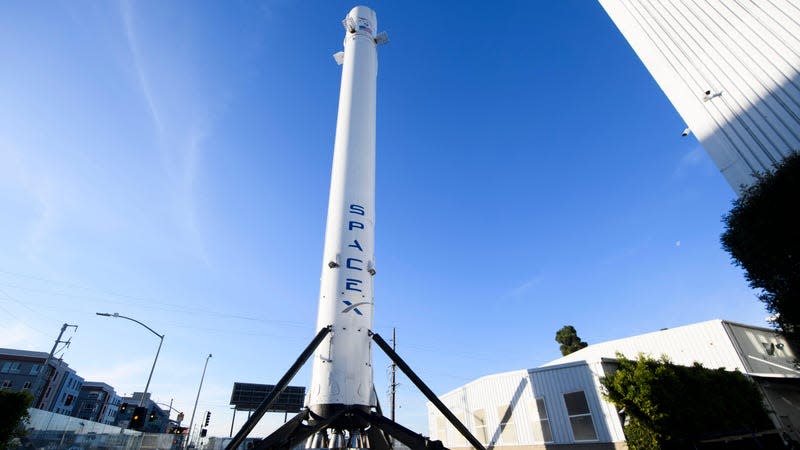Veteran SpaceX Technician Spends Months in a Coma After Rocket Engine Test Accident

The recovered first stage of a Falcon 9 rocket was put on display around SpaceX’s offices in Hawthorne, California last year. The rocket used a model of the Raptor engine.
Rocket technicians working on the front lines of the private-era space race are literally playing with fire. New details on how one SpaceX employee, who suffered grave injuries during a routine test, offer a new sense of the costs for the lightning-pace that companies are working at to put more rockets into the big black.
According to a Tuesday report from Semafor, a 10-year veteran of SpaceX suffered severe head trauma and was in a months-long coma after a routine test of the SpaceX Raptor V2 rocket engine went sideways earlier this year.
Read more
The employee was identified as Francisco Cabada, a father of three who lives in Los Angeles, according to former SpaceX intern Julia Crowley Farenga, who talked to Business Insider. Other unnamed sources from Semafor and Insider confirmed his name and extensive injuries.
According to an Occupational Safety and Health Administration (OSHA) report opened in February, at around 12:45 p.m. PT on January 18, an employee described as an “integration technician” was performing pneumatic pressure checks on the Raptor V2 engine. The employee used an automated program instead of the normal manual method as done previously. The technician was then struck by the fuel controller cover after it was sheared off from the controller module by the released pressure.
As the report notes, the technician suffered a skull fracture and head trauma, which led to his months-long coma. SpaceX was fined $18,475 through July and August for two safety violations, one labeled “serious” and with a gravity rating of 10. OSHA uses “gravity” to evaluate the severity of a violation for determining fines, in which 10 is the highest possible rating. The OSHA case remains open.
Crowley-Farenga told Insider that the sheered-off plate knocked Cabada to the ground, but the injuries were apparently more extensive than OSHA’s short description seemed to indicate. Citing California’s Department of Industrial Relations, Semafor noted the injuries not only impacted his head, but also his respiratory system, and upper and lower extremities.
As Semafor reports, unnamed sources with knowledge of the accident claimed that Cabada was not supposed to be standing so close to the valve when it hit maximum pressure. Still, pressure ramped up faster than the engineers anticipated, which gave the injured technician little time to move before the valve cover ripped off its hinge and struck him to the floor.
Attorneys for the Cabada family told Semafor that the technician is no longer in a coma but he remains unable to communicate and still requires medical treatment. A GoFundMe for Cabada, established by his sister-in-law, has reached nearly $52,500 as of the time of reporting. Semafor noted that an original photo of Cabada wearing a SpaceX hoodie was replaced by another image after the family began legal talks with the company. Many of the GoFundMe campaign donations have come from current or past SpaceX employees.
SpaceX and its founder Elon Musk have not made any public statements about the incident. Gizmodo reached out to contacts for Musk and SpaceX, but since the multi-billionaire’s companies have nixed their PR departments, we do not expect to hear back.
As noted by Semafor, it’s not uncommon for technician injuries and deaths to go unnoticed. The outlet does not cite a source, but wrote that at least 24 spaceflight workers have been killed since 1980.
Most of the noted rocket and space-related deaths have been major new events, like the Space Shuttle Challenger disaster in 1986, but these high-profile events usually involve astronauts and pilots. One of the biggest disasters in spaceflight history, the Soviet Union’s Nedelin catastrophe in 1960, led to the deaths of possibly hundreds of ground crew, though the exact number killed remains unknown.
The Raptor engines are designed to power SpaceX’s upcoming Starship megarocket, both for its first-stage booster and upper-stage spacecraft. These engines are extremely complicated systems and we’ve seen what happens when things go wrong. Back in July, the area beneath Starship’s booster rocket unexpectedly exploded in a giant fireball when a mix of methane and oxygen gas was accidentally ignited. Thankfully, there were no reported injuries.
Tests of the six Raptor engines on the spacecraft seemed to go well back in September save for a large brush fire surrounding the SpaceX Starbase facility in Boca Chica, Texas.
More: NASA Is Ready to Resume Spacewalks After Investigation Into Scary Water Leak.
More from Gizmodo
Sign up for Gizmodo's Newsletter. For the latest news, Facebook, Twitter and Instagram.

